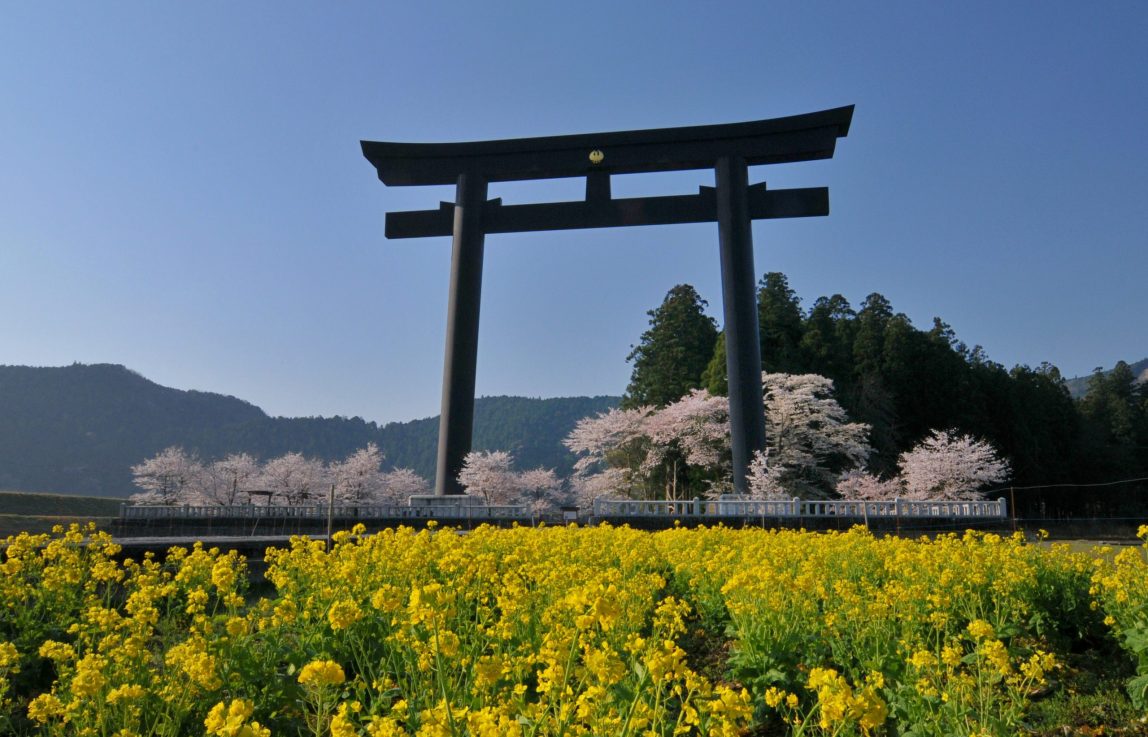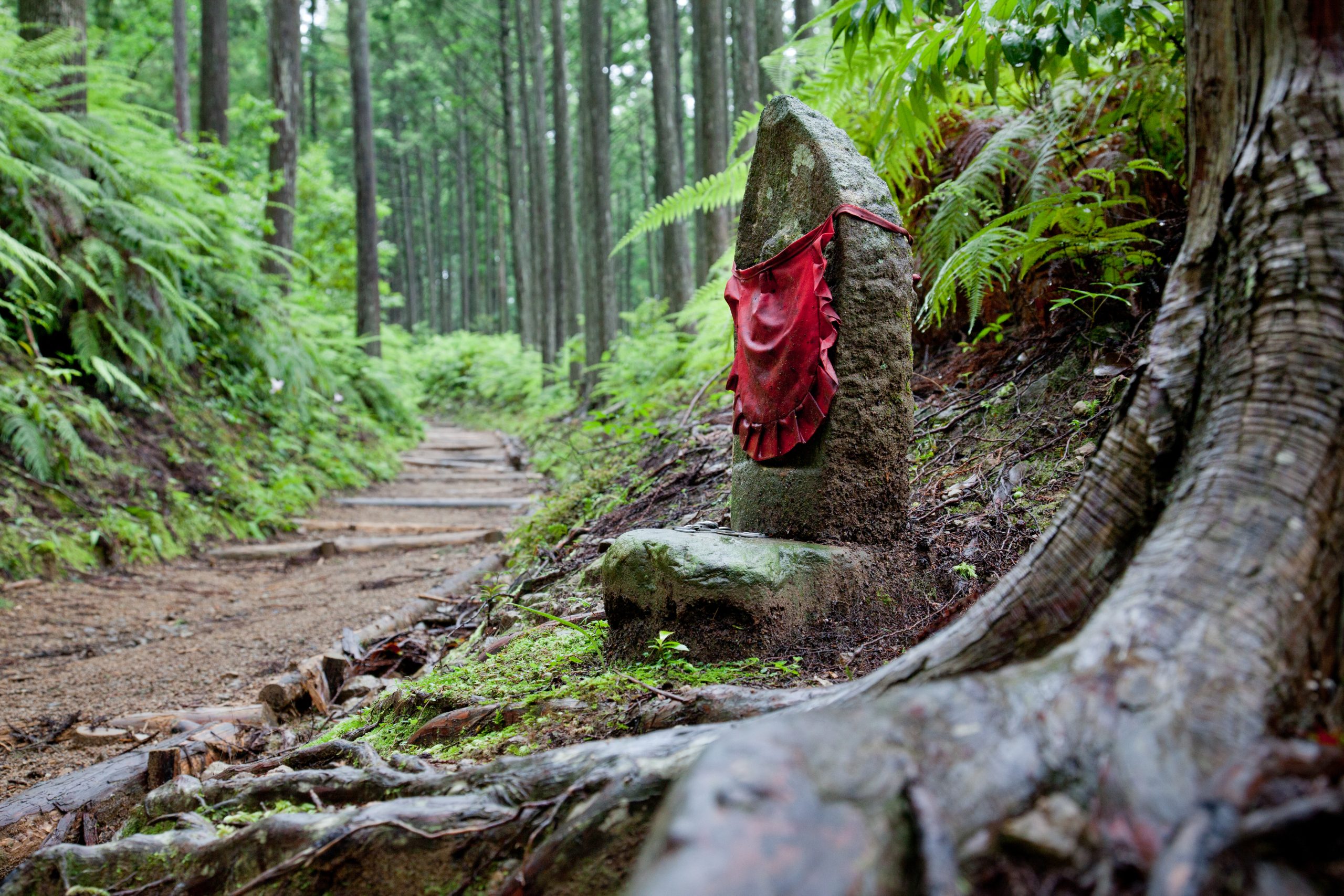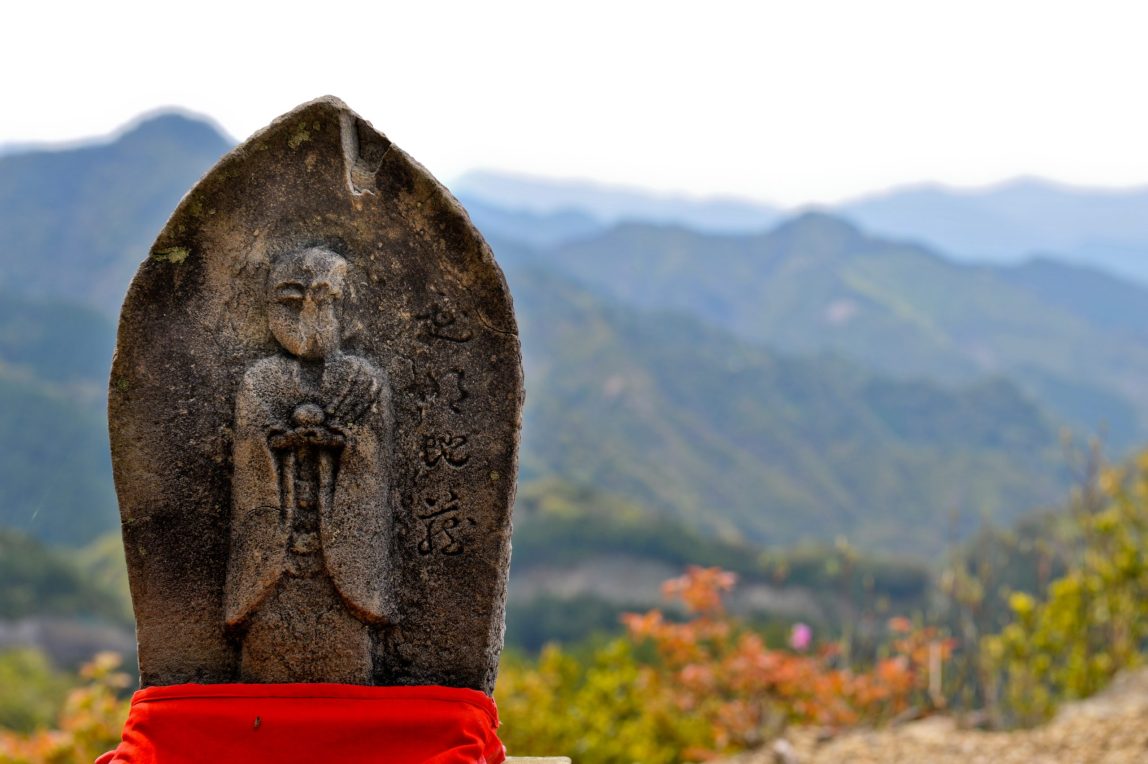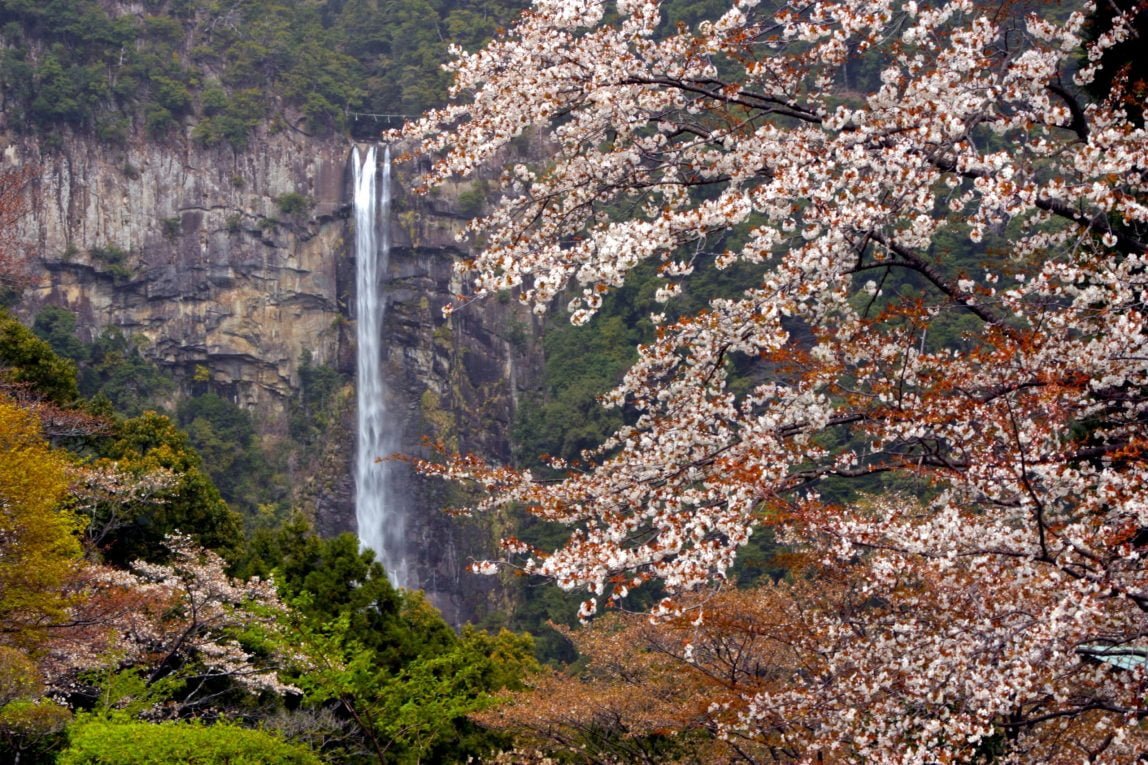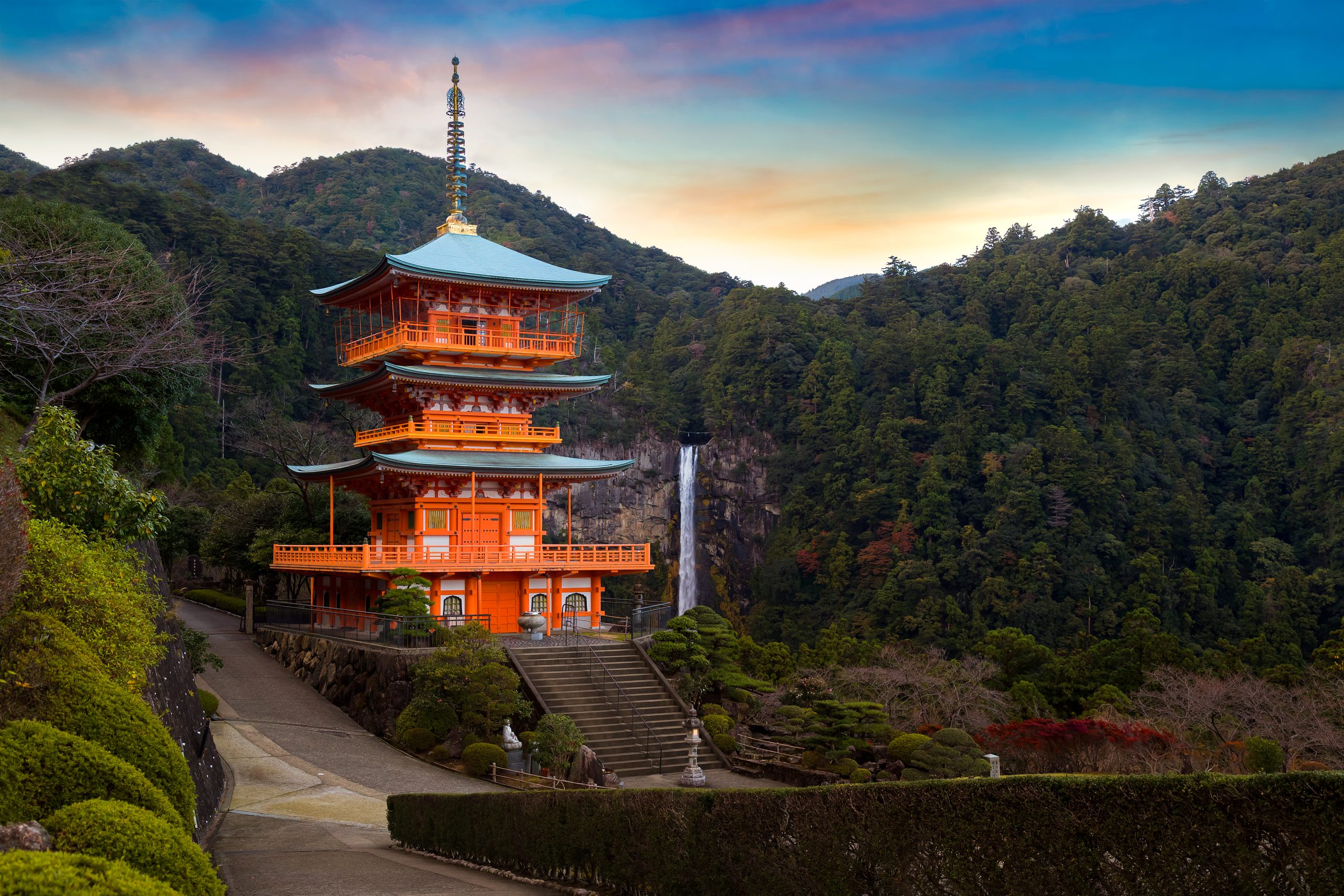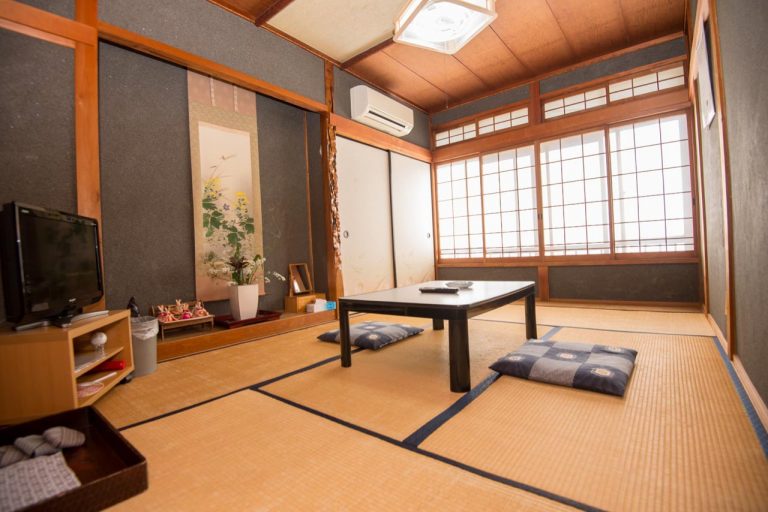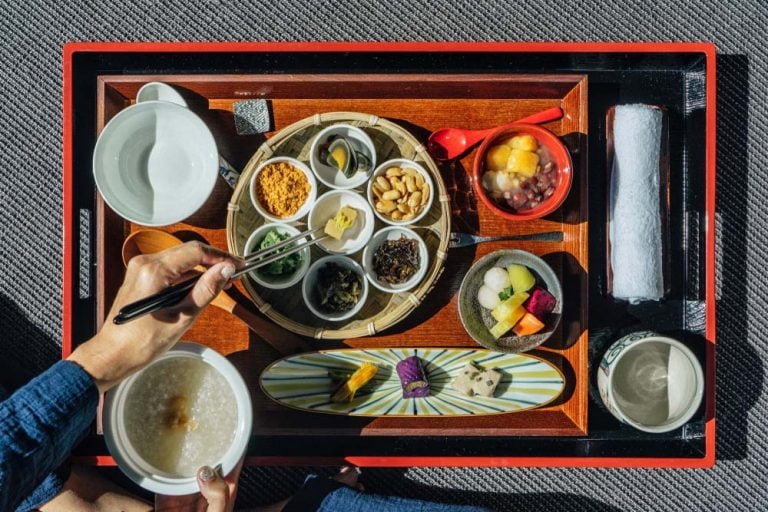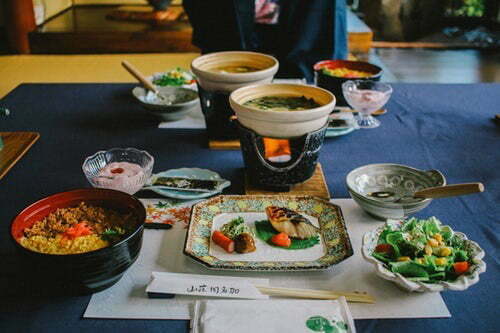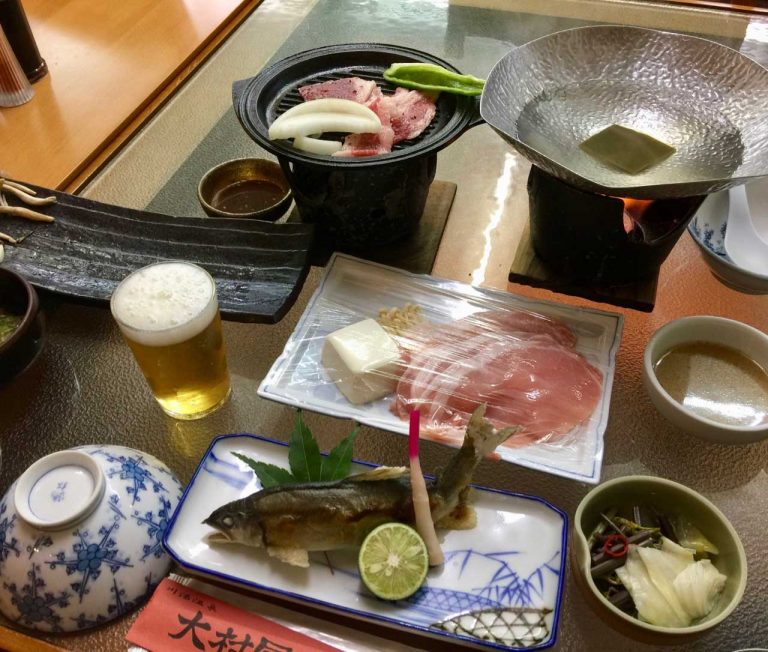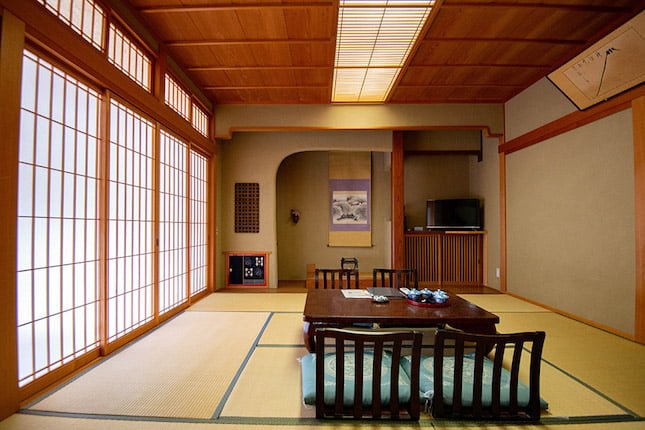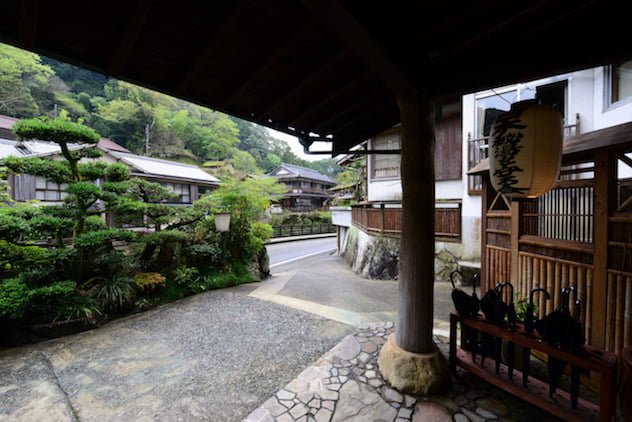 30 years' experience providing walking holidays worldwide
30 years' experience providing walking holidays worldwide-
SELF-GUIDED
-
5 DAYS
-
Moderate to Challenging
OVERVIEW
OVERVIEW
This walk contains what we think are the must-do sections of the 1200-year-old Kumano Kodo trail over 5 days. It traverses the sacred Kii mountain range through villages and forests to extraordinary ancient shrines and waterfalls. You get to walk in the footsteps of imperial and aristocratic families who walked this track as far back as 794AD.
The Kumano Kodo is one of only two world heritage-listed walks, with unmissable views over the 3600 peaks and the mountaintop sanctuary of Nachisan. At night, soak in an onsen while staying in traditional Japanese accommodation, savouring elaborate traditional Japanese multi-course dinners and breakfasts.
HIGHLIGHTS:
- A trip for those who want a taste of the Kumano Kodo experience but don't have the time to do the whole thing
- An ancient hike through Buddhist and Shinto history together with an immersive Japanese cultural experience
- Walk pack free on well-graded trails with wondrous views, and bathe in onsens
- Marvel at the incredible Grand Shrines at Hongu and Nachi-san
- The beautiful spectacle of Nachi waterfall, the tallest in Japan
- Options to vary the lengths of walks on most days should you prefer
ITINERARY
WHAT’S INCLUDED
- Walk our favourite walks on the Kumano Kodo Nakahechi over 4 days via the magnificent shrines of Hongu and the much-celebrated Nachi waterfall and shrine complex
- Stay 4 nights in an intimate family-run or small traditional Japanese lodgings, some with in-house onsens
- Walk pack free with luggage transfers from accommodation to accommodation
- Superb traditional multi-course meals for breakfast and dinner each day on the walk. Plus 3 walkers lunches
- Itineraries can be flexible to shorten the walking or slow the trip down by adding rest days
- Enjoy worry-free navigation with Stroll’s comprehensive track notes and maps
- On the ground support from local representatives
ACCOMMODATION & DINING
You will spend each night in a traditional Japanese Minshuku or Ryokan-style accommodation. These Japanese guesthouses come in a number of styles ranging from traditional wooden structures to more modern hybrid hotels.
A Minshuku is a family-run accommodation that are often found in rural Japan. There is a fine line between a Minshuku and some smaller Ryokans, making it hard to distinguish between the two. Most Minshukus are very small, with only a few Japanese-style rooms, a bit like a Bed and Breakfast Japanese style. Staying at a Minshuku has its advantages, as it is a good chance to meet the local people and get right up close to the Japanese culture. The atmosphere is often like that of a home with traditional meals served much like at a Ryokan but with even more intimacy. Be prepared, as baths and toilets are often shared.
Ryokans have Japanese-style rooms with tatami mats, shoji sliding doors, and futons for sleeping on. Few Ryokan Hotels have rooms with actual beds. The rooms may or may not have ensuites, but be prepared for a little luxury when it comes to the heated toilet seats. The bathing area is often the pride of the Ryokan, especially when they’re located in an onsen area. These are usually communal and separated by gender.
Meals are elaborate affairs from a western point of view served in a traditional dining area. A traditional Kaiseki set meal is what is usually offered. Sometimes there is the option of a buffet at the larger Ryokans.
Please note that we will endeavour to book the accommodation displayed. However, if unavailable, we will book alternative accommodation at the same standard.
GENERAL INFO
AVAILABILITY
This walk is available all year round, but you may encounter some snow from December to February. Many people prefer to walk in spring to see the cherry blossoms and in autumn because of the change of seasons and the good weather.
HOW TO GET THERE AND AWAY
Travelling to the Start of the walk
This walk starts in the Hongu region (train to Tanabe from Osaka and bus to either Yunomine, Kawayu or Wataze Onsen) and ends in Nachi-san or Nachi-Katsuura. You will need to get yourself to and from the start and end of your walk (i.e. you will need to organise your travel to the start of the walk in Hongu and then onwards from your last accommodation). To make it easy we have collated some useful information that will assist you in making arrangements for your travel.
By Air: By far, the best option is to fly into Osaka and take the train from there. You can take the train direct from Osaka Kansai Airport to Kii-Tanabe (train station). Take a local train for a few stops and then hop on the Kii Peninsula JR West train. The train station is at the airport, and there are English speaking staff at the ticket office. You might consider spending some time in Osaka. Osaka is a very interesting city and has many beautiful temples and of course Osaka Castle. In spring it is particularly beautiful. It also has a sophisticated restaurant culture and markets that seem to go on for kilometres, literally.
By rail and bus: Japan has one of the best train systems in the world, so it’s very easy to catch a train to any destination in the country. An express train is the fastest way to travel to the area. Travelling in Japan on trains is a seamless experience, and it is not necessary to always pre-purchase tickets. There’s plenty of rail staff that speak English well enough to direct you the right way and to converse with you about how to buy your ticket. Please talk to our destination consultants if you’d like any more information.
Hyperdia is a great website resource to figure out when and where your train departs. It might be best to buy your train ticket on the JR train network when you first arrive in Japan so you can relax. However, the trains run often and are so efficient that you shouldn’t have any trouble just arriving 20 minutes beforehand and buying a ticket. JR passes can be a convenient and reasonable way to get around the area. There are two regional JR passes that cover the Kii Peninsula: Kansai WIDE Area Pass, and Ise-Kumano-Wakayama Area Tourist Pass.
The journey from Osaka to Tanabe takes about 1 – 2 hours and costs about YEN 3,800. You can take the train direct from Osaka Kansai Airport to Kii-Tanabe (train station). Take a local train to Hineno station then hop on the Kii Peninsula JR West train. The train station is at the airport, and there are English-speaking staff at the ticket office.
If you stay in Osaka then you’ll need to catch the subway (Osaka Metro Midosuji) to Tennoji station. The tickets can be purchased locally. From Tennoji it’s a JR train service to Kii-Tanabe bound for Shirahama.
The bus station for your onward journey to the Hongu region is located in front of the Kii-Tanabe train station, the ticket can be bought at the Visitors Information Centre next to the train station. The buses depart every 30 minutes or so and take about 1.5 – 2 hours and costs about YEN 2,700 – YEN 4,200 depending on the service. All details will be made available in your notes and during your briefing session with a local representative in Tanabe.
Travelling from the end of the walk
By rail: The train from Kii-Katsuura (train station a short distance from Nachisan by bus) back to Osaka takes about 4 hours and costs about YEN 4,700. You can also choose to go to Tokyo or anywhere else for that matter in Japan. However, you most likely will need to travel through a major city to get there.
By Air: See above
WALKING
The walk is moderate to moderate-to-challenging with some long days if you wish. Full day walks average about 15 km with 5 –7 hours walking each day. The walking is over well-maintained paths but expect each day to start with some reasonable elevation gains.
This historic route has stacks of small temples (Oji) and statues to admire along the way. For much of the time, you are walking under a forest canopy which makes for mild conditions, other than in the height of summer.
For what to bring, please refer to Gear Advice on our FAQ section.
WEATHER
From the end of March, the temperature begins to increase. In summer it’s quite warm and humid but still good for walking, particularly if you enjoy warmer temperatures and taking a dip in a stream.
The walk is offered in winter but bring some warm clothes and good rain gear. The area is just as beautiful if not more and is not busy at all. Soaking in an outside onsen in the cool of the night is one of those real authentic Japanese experiences that you can look forward to after a big day on the track.
As walkers, we believe spring and autumn to be the best time as the weather is perfect for walking.
See the weather information about Osaka’s average weather at different times of the year.
INSURANCE
We require that you have adequate travel insurance against potential losses, damage or injury, including cancellation costs and loss of luggage.
For all trips that require international travel, you must have purchased travel insurance that also includes medical evacuation coverage.
We also charge a cancellation fee if you cancel your walking holiday after we have confirmed it to cover costs incurred from our suppliers and in the office. See the FAQ section for more information.
INFORMATION PACK
For nearly 30 years we have taken pride in providing seamlessly organised walking holidays, but we know, even with that in mind, that you’ll have many more questions. You will receive a very detailed information pack and itinerary approximately 6 weeks out from departure outlining all the fine detail and much more.
CONTACT
If you have any questions, feel free to ask one of our destination consultants. You can get in touch with us via our contact form or email us at info@stroll.com
MAP

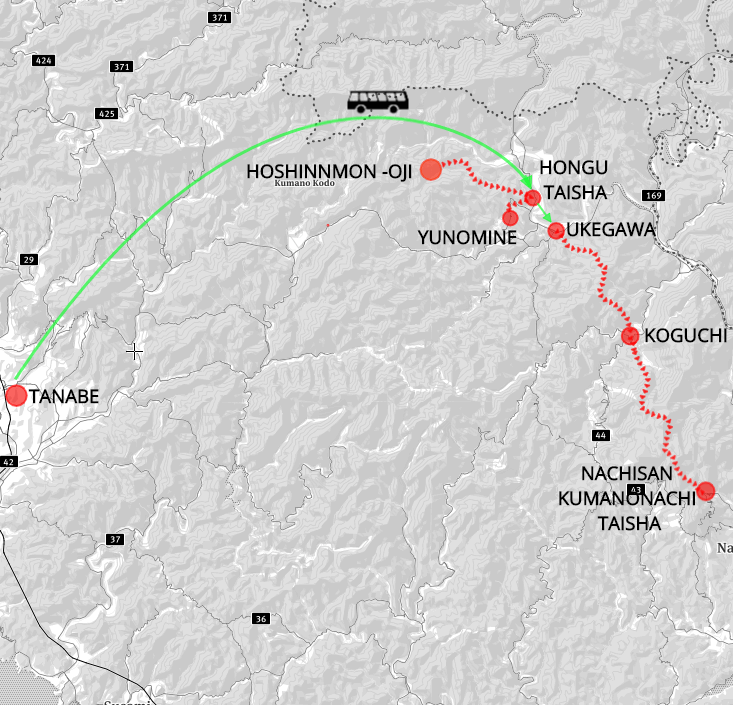
DEPARTURE DATES
-
DATESAVAILABILITYPRICESingle OccupancyDetails
-
1 Jun 2024 - 31 Jul 2024AVAILABLE
from £ 1040
SINGLE OCCUPANCY£ 75 -
1 Aug 2024 - 31 Dec 2024AVAILABLE
from £ 1145
SINGLE OCCUPANCY£ 85 -
1 Jan 2025 - 28 Feb 2025AVAILABLE
from £ 1080
SINGLE OCCUPANCY£ 90 -
1 Mar 2025 - 31 May 2025AVAILABLE
from £ 1190
SINGLE OCCUPANCY£ 95 -
1 Jun 2025 - 31 Jul 2025AVAILABLE
from £ 1080
SINGLE OCCUPANCY£ 90 -
1 Aug 2025 - 31 Dec 2025AVAILABLE
from £ 1190
SINGLE OCCUPANCY£ 95 -
1 Jan 2026 - 28 Feb 2026AVAILABLE
from £ 1125
SINGLE OCCUPANCY£ 90 -
1 Mar 2026 - 31 May 2026AVAILABLE
from £ 1240
SINGLE OCCUPANCY£ 100 -
1 Jun 2026 - 31 Jul 2026AVAILABLE
from £ 1125
SINGLE OCCUPANCY£ 90 -
1 Aug 2026 - 31 Dec 2026AVAILABLE
from £ 1240
SINGLE OCCUPANCY£ 100
sections
This walk contains what we think are the must-do sections of the 1200-year-old Kumano Kodo trail over 5 days. It traverses the sacred Kii mountain range through villages and forests to extraordinary ancient shrines and waterfalls. You get to walk in the footsteps of imperial and aristocratic families who walked this track as far back as 794AD.
The Kumano Kodo is one of only two world heritage-listed walks, with unmissable views over the 3600 peaks and the mountaintop sanctuary of Nachisan. At night, soak in an onsen while staying in traditional Japanese accommodation, savouring elaborate traditional Japanese multi-course dinners and breakfasts.
HIGHLIGHTS:
- A trip for those who want a taste of the Kumano Kodo experience but don't have the time to do the whole thing
- An ancient hike through Buddhist and Shinto history together with an immersive Japanese cultural experience
- Walk pack free on well-graded trails with wondrous views, and bathe in onsens
- Marvel at the incredible Grand Shrines at Hongu and Nachi-san
- The beautiful spectacle of Nachi waterfall, the tallest in Japan
- Options to vary the lengths of walks on most days should you prefer
- Walk our favourite walks on the Kumano Kodo Nakahechi over 4 days via the magnificent shrines of Hongu and the much-celebrated Nachi waterfall and shrine complex
- Stay 4 nights in an intimate family-run or small traditional Japanese lodgings, some with in-house onsens
- Walk pack free with luggage transfers from accommodation to accommodation
- Superb traditional multi-course meals for breakfast and dinner each day on the walk. Plus 3 walkers lunches
- Itineraries can be flexible to shorten the walking or slow the trip down by adding rest days
- Enjoy worry-free navigation with Stroll’s comprehensive track notes and maps
- On the ground support from local representatives
You will spend each night in a traditional Japanese Minshuku or Ryokan-style accommodation. These Japanese guesthouses come in a number of styles ranging from traditional wooden structures to more modern hybrid hotels.
A Minshuku is a family-run accommodation that are often found in rural Japan. There is a fine line between a Minshuku and some smaller Ryokans, making it hard to distinguish between the two. Most Minshukus are very small, with only a few Japanese-style rooms, a bit like a Bed and Breakfast Japanese style. Staying at a Minshuku has its advantages, as it is a good chance to meet the local people and get right up close to the Japanese culture. The atmosphere is often like that of a home with traditional meals served much like at a Ryokan but with even more intimacy. Be prepared, as baths and toilets are often shared.
Ryokans have Japanese-style rooms with tatami mats, shoji sliding doors, and futons for sleeping on. Few Ryokan Hotels have rooms with actual beds. The rooms may or may not have ensuites, but be prepared for a little luxury when it comes to the heated toilet seats. The bathing area is often the pride of the Ryokan, especially when they’re located in an onsen area. These are usually communal and separated by gender.
Meals are elaborate affairs from a western point of view served in a traditional dining area. A traditional Kaiseki set meal is what is usually offered. Sometimes there is the option of a buffet at the larger Ryokans.
Please note that we will endeavour to book the accommodation displayed. However, if unavailable, we will book alternative accommodation at the same standard.
AVAILABILITY
This walk is available all year round, but you may encounter some snow from December to February. Many people prefer to walk in spring to see the cherry blossoms and in autumn because of the change of seasons and the good weather.
HOW TO GET THERE AND AWAY
Travelling to the Start of the walk
This walk starts in the Hongu region (train to Tanabe from Osaka and bus to either Yunomine, Kawayu or Wataze Onsen) and ends in Nachi-san or Nachi-Katsuura. You will need to get yourself to and from the start and end of your walk (i.e. you will need to organise your travel to the start of the walk in Hongu and then onwards from your last accommodation). To make it easy we have collated some useful information that will assist you in making arrangements for your travel.
By Air: By far, the best option is to fly into Osaka and take the train from there. You can take the train direct from Osaka Kansai Airport to Kii-Tanabe (train station). Take a local train for a few stops and then hop on the Kii Peninsula JR West train. The train station is at the airport, and there are English speaking staff at the ticket office. You might consider spending some time in Osaka. Osaka is a very interesting city and has many beautiful temples and of course Osaka Castle. In spring it is particularly beautiful. It also has a sophisticated restaurant culture and markets that seem to go on for kilometres, literally.
By rail and bus: Japan has one of the best train systems in the world, so it’s very easy to catch a train to any destination in the country. An express train is the fastest way to travel to the area. Travelling in Japan on trains is a seamless experience, and it is not necessary to always pre-purchase tickets. There’s plenty of rail staff that speak English well enough to direct you the right way and to converse with you about how to buy your ticket. Please talk to our destination consultants if you’d like any more information.
Hyperdia is a great website resource to figure out when and where your train departs. It might be best to buy your train ticket on the JR train network when you first arrive in Japan so you can relax. However, the trains run often and are so efficient that you shouldn’t have any trouble just arriving 20 minutes beforehand and buying a ticket. JR passes can be a convenient and reasonable way to get around the area. There are two regional JR passes that cover the Kii Peninsula: Kansai WIDE Area Pass, and Ise-Kumano-Wakayama Area Tourist Pass.
The journey from Osaka to Tanabe takes about 1 – 2 hours and costs about YEN 3,800. You can take the train direct from Osaka Kansai Airport to Kii-Tanabe (train station). Take a local train to Hineno station then hop on the Kii Peninsula JR West train. The train station is at the airport, and there are English-speaking staff at the ticket office.
If you stay in Osaka then you’ll need to catch the subway (Osaka Metro Midosuji) to Tennoji station. The tickets can be purchased locally. From Tennoji it’s a JR train service to Kii-Tanabe bound for Shirahama.
The bus station for your onward journey to the Hongu region is located in front of the Kii-Tanabe train station, the ticket can be bought at the Visitors Information Centre next to the train station. The buses depart every 30 minutes or so and take about 1.5 – 2 hours and costs about YEN 2,700 – YEN 4,200 depending on the service. All details will be made available in your notes and during your briefing session with a local representative in Tanabe.
Travelling from the end of the walk
By rail: The train from Kii-Katsuura (train station a short distance from Nachisan by bus) back to Osaka takes about 4 hours and costs about YEN 4,700. You can also choose to go to Tokyo or anywhere else for that matter in Japan. However, you most likely will need to travel through a major city to get there.
By Air: See above
WALKING
The walk is moderate to moderate-to-challenging with some long days if you wish. Full day walks average about 15 km with 5 –7 hours walking each day. The walking is over well-maintained paths but expect each day to start with some reasonable elevation gains.
This historic route has stacks of small temples (Oji) and statues to admire along the way. For much of the time, you are walking under a forest canopy which makes for mild conditions, other than in the height of summer.
For what to bring, please refer to Gear Advice on our FAQ section.
WEATHER
From the end of March, the temperature begins to increase. In summer it’s quite warm and humid but still good for walking, particularly if you enjoy warmer temperatures and taking a dip in a stream.
The walk is offered in winter but bring some warm clothes and good rain gear. The area is just as beautiful if not more and is not busy at all. Soaking in an outside onsen in the cool of the night is one of those real authentic Japanese experiences that you can look forward to after a big day on the track.
As walkers, we believe spring and autumn to be the best time as the weather is perfect for walking.
See the weather information about Osaka’s average weather at different times of the year.
INSURANCE
We require that you have adequate travel insurance against potential losses, damage or injury, including cancellation costs and loss of luggage.
For all trips that require international travel, you must have purchased travel insurance that also includes medical evacuation coverage.
We also charge a cancellation fee if you cancel your walking holiday after we have confirmed it to cover costs incurred from our suppliers and in the office. See the FAQ section for more information.
INFORMATION PACK
For nearly 30 years we have taken pride in providing seamlessly organised walking holidays, but we know, even with that in mind, that you’ll have many more questions. You will receive a very detailed information pack and itinerary approximately 6 weeks out from departure outlining all the fine detail and much more.
CONTACT
If you have any questions, feel free to ask one of our destination consultants. You can get in touch with us via our contact form or email us at info@stroll.com
-
DATESAVAILABILITYPRICESingle OccupancyDETAILS
-
Date1 Jun 2024 - 31 Jul 2024AVAILIBILITYAVAILABLEPRICEfrom £ 1040SINGLE OCCUPANCY£ 75DETAILS
-
Date1 Aug 2024 - 31 Dec 2024AVAILIBILITYAVAILABLEPRICEfrom £ 1145SINGLE OCCUPANCY£ 85DETAILS
-
Date1 Jan 2025 - 28 Feb 2025AVAILIBILITYAVAILABLEPRICEfrom £ 1080SINGLE OCCUPANCY£ 90DETAILS
-
Date1 Mar 2025 - 31 May 2025AVAILIBILITYAVAILABLEPRICEfrom £ 1190SINGLE OCCUPANCY£ 95DETAILS
-
Date1 Jun 2025 - 31 Jul 2025AVAILIBILITYAVAILABLEPRICEfrom £ 1080SINGLE OCCUPANCY£ 90DETAILS
-
Date1 Aug 2025 - 31 Dec 2025AVAILIBILITYAVAILABLEPRICEfrom £ 1190SINGLE OCCUPANCY£ 95DETAILS
-
Date1 Jan 2026 - 28 Feb 2026AVAILIBILITYAVAILABLEPRICEfrom £ 1125SINGLE OCCUPANCY£ 90DETAILS
-
Date1 Mar 2026 - 31 May 2026AVAILIBILITYAVAILABLEPRICEfrom £ 1240SINGLE OCCUPANCY£ 100DETAILS
-
Date1 Jun 2026 - 31 Jul 2026AVAILIBILITYAVAILABLEPRICEfrom £ 1125SINGLE OCCUPANCY£ 90DETAILS
-
Date1 Aug 2026 - 31 Dec 2026AVAILIBILITYAVAILABLEPRICEfrom £ 1240SINGLE OCCUPANCY£ 100DETAILS





